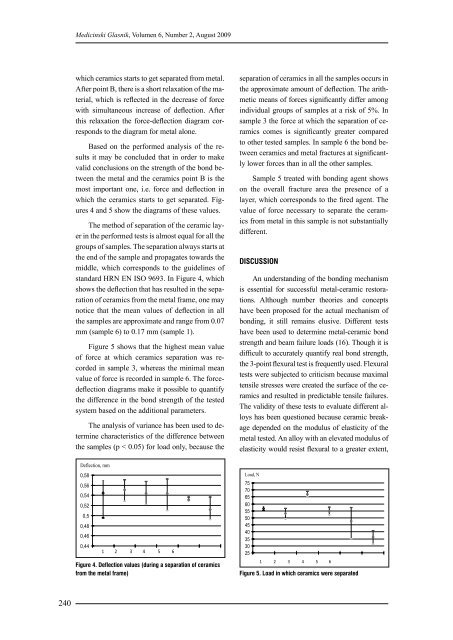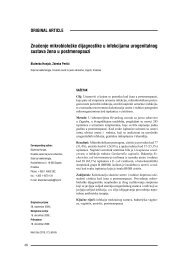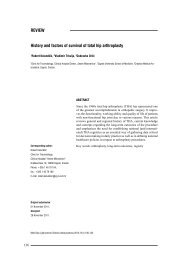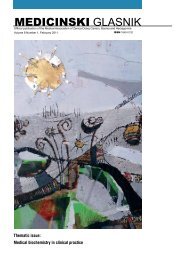Influence of cast surface finishing process on metal-ceramic bond ...
Influence of cast surface finishing process on metal-ceramic bond ...
Influence of cast surface finishing process on metal-ceramic bond ...
Create successful ePaper yourself
Turn your PDF publications into a flip-book with our unique Google optimized e-Paper software.
240<br />
Medicinski Glasnik, Volumen 6, Number 2, August 2009<br />
which <strong>ceramic</strong>s starts to get separated from <strong>metal</strong>.<br />
After point B, there is a short relaxati<strong>on</strong> <str<strong>on</strong>g>of</str<strong>on</strong>g> the material,<br />
which is reflected in the decrease <str<strong>on</strong>g>of</str<strong>on</strong>g> force<br />
with simultaneous increase <str<strong>on</strong>g>of</str<strong>on</strong>g> deflecti<strong>on</strong>. After<br />
this relaxati<strong>on</strong> the force-deflecti<strong>on</strong> diagram corresp<strong>on</strong>ds<br />
to the diagram for <strong>metal</strong> al<strong>on</strong>e.<br />
Based <strong>on</strong> the performed analysis <str<strong>on</strong>g>of</str<strong>on</strong>g> the results<br />
it may be c<strong>on</strong>cluded that in order to make<br />
valid c<strong>on</strong>clusi<strong>on</strong>s <strong>on</strong> the strength <str<strong>on</strong>g>of</str<strong>on</strong>g> the b<strong>on</strong>d between<br />
the <strong>metal</strong> and the <strong>ceramic</strong>s point B is the<br />
most important <strong>on</strong>e, i.e. force and deflecti<strong>on</strong> in<br />
which the <strong>ceramic</strong>s starts to get separated. Figures<br />
4 and 5 show the diagrams <str<strong>on</strong>g>of</str<strong>on</strong>g> these values.<br />
The method <str<strong>on</strong>g>of</str<strong>on</strong>g> separati<strong>on</strong> <str<strong>on</strong>g>of</str<strong>on</strong>g> the <strong>ceramic</strong> layer<br />
in the performed tests is almost equal for all the<br />
groups <str<strong>on</strong>g>of</str<strong>on</strong>g> samples. The separati<strong>on</strong> always starts at<br />
the end <str<strong>on</strong>g>of</str<strong>on</strong>g> the sample and propagates towards the<br />
middle, which corresp<strong>on</strong>ds to the guidelines <str<strong>on</strong>g>of</str<strong>on</strong>g><br />
standard HRN EN ISO 9693. In Figure 4, which<br />
shows the deflecti<strong>on</strong> that has resulted in the separati<strong>on</strong><br />
<str<strong>on</strong>g>of</str<strong>on</strong>g> <strong>ceramic</strong>s from the <strong>metal</strong> frame, <strong>on</strong>e may<br />
notice that the mean values <str<strong>on</strong>g>of</str<strong>on</strong>g> deflecti<strong>on</strong> in all<br />
the samples are approximate and range from 0.07<br />
mm (sample 6) to 0.17 mm (sample 1).<br />
Figure 5 shows that the highest mean value<br />
<str<strong>on</strong>g>of</str<strong>on</strong>g> force at which <strong>ceramic</strong>s separati<strong>on</strong> was recorded<br />
in sample 3, whereas the minimal mean<br />
value <str<strong>on</strong>g>of</str<strong>on</strong>g> force is recorded in sample 6. The forcedeflecti<strong>on</strong><br />
diagrams make it possible to quantify<br />
the difference in the b<strong>on</strong>d strength <str<strong>on</strong>g>of</str<strong>on</strong>g> the tested<br />
system based <strong>on</strong> the additi<strong>on</strong>al parameters.<br />
The analysis <str<strong>on</strong>g>of</str<strong>on</strong>g> variance has been used to determine<br />
characteristics <str<strong>on</strong>g>of</str<strong>on</strong>g> the difference between<br />
the samples (p < 0.05) for load <strong>on</strong>ly, because the<br />
separati<strong>on</strong> <str<strong>on</strong>g>of</str<strong>on</strong>g> <strong>ceramic</strong>s in all the samples occurs in<br />
the approximate amount <str<strong>on</strong>g>of</str<strong>on</strong>g> deflecti<strong>on</strong>. The arithmetic<br />
means <str<strong>on</strong>g>of</str<strong>on</strong>g> forces significantly differ am<strong>on</strong>g<br />
individual groups <str<strong>on</strong>g>of</str<strong>on</strong>g> samples at a risk <str<strong>on</strong>g>of</str<strong>on</strong>g> 5%. In<br />
sample 3 the force at which the separati<strong>on</strong> <str<strong>on</strong>g>of</str<strong>on</strong>g> <strong>ceramic</strong>s<br />
comes is significantly greater compared<br />
to other tested samples. In sample 6 the b<strong>on</strong>d between<br />
<strong>ceramic</strong>s and <strong>metal</strong> fractures at significantly<br />
lower forces than in all the other samples.<br />
Sample 5 treated with b<strong>on</strong>ding agent shows<br />
<strong>on</strong> the overall fracture area the presence <str<strong>on</strong>g>of</str<strong>on</strong>g> a<br />
layer, which corresp<strong>on</strong>ds to the fired agent. The<br />
value <str<strong>on</strong>g>of</str<strong>on</strong>g> force necessary to separate the <strong>ceramic</strong>s<br />
from <strong>metal</strong> in this sample is not substantially<br />
different.<br />
DISCUSSION<br />
An understanding <str<strong>on</strong>g>of</str<strong>on</strong>g> the b<strong>on</strong>ding mechanism<br />
is essential for successful <strong>metal</strong>-<strong>ceramic</strong> restorati<strong>on</strong>s.<br />
Although number theories and c<strong>on</strong>cepts<br />
have been proposed for the actual mechanism <str<strong>on</strong>g>of</str<strong>on</strong>g><br />
b<strong>on</strong>ding, it still remains elusive. Different tests<br />
have been used to determine <strong>metal</strong>-<strong>ceramic</strong> b<strong>on</strong>d<br />
strength and beam failure loads (16). Though it is<br />
difficult to accurately quantify real b<strong>on</strong>d strength,<br />
the 3-point flexural test is frequently used. Flexural<br />
tests were subjected to criticism because maximal<br />
tensile stresses were created the <str<strong>on</strong>g>surface</str<strong>on</strong>g> <str<strong>on</strong>g>of</str<strong>on</strong>g> the <strong>ceramic</strong>s<br />
and resulted in predictable tensile failures.<br />
The validity <str<strong>on</strong>g>of</str<strong>on</strong>g> these tests to evaluate different alloys<br />
has been questi<strong>on</strong>ed because <strong>ceramic</strong> breakage<br />
depended <strong>on</strong> the modulus <str<strong>on</strong>g>of</str<strong>on</strong>g> elasticity <str<strong>on</strong>g>of</str<strong>on</strong>g> the<br />
<strong>metal</strong> tested. An alloy with an elevated modulus <str<strong>on</strong>g>of</str<strong>on</strong>g><br />
elasticity would resist flexural to a greater extent,<br />
Figure 4. Deflecti<strong>on</strong> values (during a separati<strong>on</strong> <str<strong>on</strong>g>of</str<strong>on</strong>g> <strong>ceramic</strong>s<br />
from the <strong>metal</strong> frame) Figure 5. Load in which <strong>ceramic</strong>s were separated












